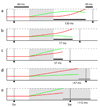Perceptual decision making in less than 30 milliseconds
- PMID: 20098418
- PMCID: PMC2834559
- DOI: 10.1038/nn.2485
Perceptual decision making in less than 30 milliseconds
Abstract
In perceptual discrimination tasks, a subject's response time is determined by both sensory and motor processes. Measuring the time consumed by the perceptual evaluation step alone is therefore complicated by factors such as motor preparation, task difficulty and speed-accuracy tradeoffs. Here we present a task design that minimizes these confounding factors and allows us to track a subject's perceptual performance with unprecedented temporal resolution. We find that monkeys can make accurate color discriminations in less than 30 ms. Furthermore, our simple task design provides a tool for elucidating how neuronal activity relates to sensory as opposed to motor processing, as demonstrated with neural data from cortical oculomotor neurons. In these cells, perceptual information acts by accelerating and decelerating the ongoing motor plans associated with correct and incorrect choices, as predicted by a race-to-threshold model, and the time course of these neural events parallels the time course of the subject's choice accuracy.
Figures







Comment in
-
Quick thinking: perceiving in a tenth of a blink of an eye.Nat Neurosci. 2010 Mar;13(3):279-80. doi: 10.1038/nn0310-279. Nat Neurosci. 2010. PMID: 20177419 No abstract available.
Similar articles
-
Tracking the temporal evolution of a perceptual judgment using a compelled-response task.J Neurosci. 2011 Jun 8;31(23):8406-21. doi: 10.1523/JNEUROSCI.1419-11.2011. J Neurosci. 2011. PMID: 21653845 Free PMC article.
-
Neurally constrained modeling of perceptual decision making.Psychol Rev. 2010 Oct;117(4):1113-43. doi: 10.1037/a0020311. Psychol Rev. 2010. PMID: 20822291 Free PMC article.
-
Neural mechanisms of speed-accuracy tradeoff.Neuron. 2012 Nov 8;76(3):616-28. doi: 10.1016/j.neuron.2012.08.030. Neuron. 2012. PMID: 23141072 Free PMC article.
-
Neural correlates of decision processes: neural and mental chronometry.Curr Opin Neurobiol. 2003 Apr;13(2):182-6. doi: 10.1016/s0959-4388(03)00039-4. Curr Opin Neurobiol. 2003. PMID: 12744971 Review.
-
Urgent Decision Making: Resolving Visuomotor Interactions at High Temporal Resolution.Annu Rev Vis Sci. 2021 Sep 15;7:323-348. doi: 10.1146/annurev-vision-100419-103842. Epub 2021 Jun 25. Annu Rev Vis Sci. 2021. PMID: 34171199 Review.
Cited by
-
The limits of deliberation in a perceptual decision task.Neuron. 2013 Apr 24;78(2):339-51. doi: 10.1016/j.neuron.2013.02.010. Epub 2013 Mar 28. Neuron. 2013. PMID: 23541901 Free PMC article.
-
Neural basis of feature-based contextual effects on visual search behavior.Front Behav Neurosci. 2012 Jan 11;5:91. doi: 10.3389/fnbeh.2011.00091. eCollection 2011. Front Behav Neurosci. 2012. PMID: 22287945 Free PMC article.
-
Cortical Specializations Underlying Fast Computations.Neuroscientist. 2016 Apr;22(2):145-64. doi: 10.1177/1073858415571539. Epub 2015 Feb 17. Neuroscientist. 2016. PMID: 25689988 Free PMC article. Review.
-
The perceptual cues that reshape expert reasoning.Sci Rep. 2012;2:502. doi: 10.1038/srep00502. Epub 2012 Jul 11. Sci Rep. 2012. PMID: 22792435 Free PMC article.
-
Fast and sensitive GCaMP calcium indicators for imaging neural populations.Nature. 2023 Mar;615(7954):884-891. doi: 10.1038/s41586-023-05828-9. Epub 2023 Mar 15. Nature. 2023. PMID: 36922596 Free PMC article.
References
-
- Ernst MO, Banks MS. Humans integrate visual and haptic information in a statistically optimal fashion. Nature. 2002;415:429–433. - PubMed
-
- Sugrue LP, Corrado GS, Newsome WT. Matching behavior and the representation of value in the parietal cortex. Science. 2004;304:1782–1787. - PubMed
-
- de Lafuente V, Romo R. Neuronal correlates of subjective sensory experience. Nature Neurosci. 2005;8:1698–1703. - PubMed
Publication types
MeSH terms
Grants and funding
LinkOut - more resources
Full Text Sources
Other Literature Sources

